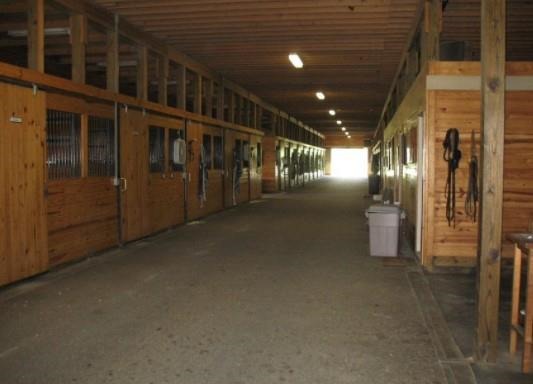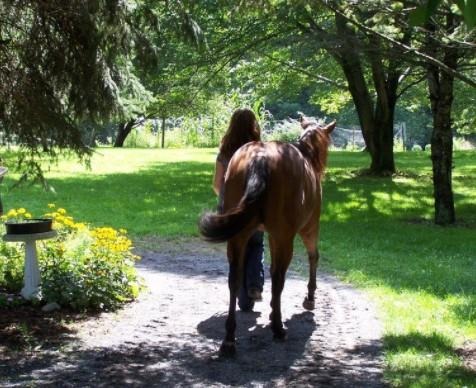By Brittani Kirkland
Fire is a serious threat at equine facilities. Many equine facilities use highly combustible items, such as hay and gasoline, in daily operations which increases the risk of starting a fire. Combine that with horses (flighty, prey animals sensitive to their surroundings) that can be severely injured by fire, and fire safety becomes a high priority for facility management. Most barn fires are preventable, and thoughtful management can help reduce the risk of incidence. Additionally, preparation can help decrease losses in the unfortunate event of a fire igniting. This article provides some easy steps that you can incorporate at your facility to prepare for and prevent fires.
Preventing Fires
Fire requires three things to begin: a fuel source, an ignition source, and oxygen. We cannot control the oxygen in the air, but we can reduce fuel and ignition sources by managing our horse facilities with fire safety in mind. Many things present on a horse farm can lead to fire, such as heaters, hay, and cobwebs. Reducing the chance of fire requires forethought about what is around your facility and if it might serve as fuel or ignition source. Here are a few items to think about and ways to reduce fuel and ignition sources:
Do not allow smoking at your equine facilities.
Make sure signs are posted throughout and that the rule is enforced. Ensure all boarders, students, family members, and visitors know about this rule and will comply.
Hay is extremely flammable, and bales should be monitored for moisture and heat.
When hay is baled too wet, excessive microbial respiration results in heat build-up and makes combustion possible during the first six weeks of storage. A hay moisture tester can tell you your hay’s moisture level. Knowing moisture level is particularly important if you purchased hay soon after baling. Ideally, hay moisture should be less than 15% for horses. It is best if hay is kept in a well-ventilated, dry storage area. Monitor heat accumulation in your hay. Multiple tools are available for temperature monitoring including probes and thermometers. Internal temperatures of 150ºF to 170ºF are dangerous and could quickly lead to combustion. If you detect this temperature, leave the hay where it is, move a safe distance away and call 9-1-1 immediately.
Store your hay in a separate building away from where horses are housed, ideally downwind of the barn.
This can help reduce the chance of injury to horses if the hay were to catch fire. Also, storing the hay in a separate building or shed can help to contain a fire to one area if the hay ignites. If you can, keep stall bedding materials, which are also flammable, away from horse housing.
Keep the facilities clean!
Clean up any loose hay on the ground and regularly wipe down stalls and rafters to remove dust and cobwebs (which collect dust and other flammable particles). These can all fuel the fire and encourage spread throughout the building, so reduce as much build-up as possible. Electrical fires can also be started from accumulated dust, chaff, bird nests, insect colonies, and webs.

Photo credit: Laura Kenny, Penn State.
Check electrical sockets, lights, heaters, and other electric items around the barn regularly.
Make sure they are working properly, free of dust and/or cobwebs, and that they are not near or lying against anything that could be flammable, such as stall bedding or winter blankets. You may want to hire an electrician to ensure everything is functioning properly and is up to code.
Do not use portable heaters or dangling heat lamps in your equine facilities.
If you must use a portable heater, for example in a tack room, ensure that you follow the manufacturer’s instructions, never leave them unattended, clean off dust regularly, and place them far from any flammable items. Only use heaters that automatically turn off if tipped over. Units with automatic shut-off timers are also recommended.
Only use stall fans that are rated for agricultural use, which can be found at farm supply stores.
The cheaper residential fans you can purchase at home stores do not have sealed motors. Many barn fires start when an unsealed motor on a stall fan fills with dust that ignites. Agricultural fans have an enclosed and sealed motor. Always follow the manufacturer’s instructions when using fans.
Check cords regularly.
Any frayed, broken, or bent cords should not be used until properly repaired. Make sure horses cannot chew or step on any wires or cords around the facility. All appliances should be UL approved.
Store and dispose of combustible materials appropriately.
If possible, keep items such gasoline, propane, and fertilizer in a separate building away from areas where horses will be or where hay might be stored. Paint, chemicals, and aerosol cans are a few other items that might be lying around your facility that could serve as a fire source. Store these properly.
Be Prepared for a Fire to Start
As with any disaster, preparation is key to protecting you, your horses, and your facility from fire. Preparing for a fire can help you respond quickly and efficiently. It can also reduce losses and save lives. It is important for you, and others who frequently visit your facility, to know the facility’s plan of action in the event of a fire. This will help individuals (and even your horses) be ready for quick action. Some steps for fire preparedness include:
Make sure the fire department can find the facility and easily access it in the event of an emergency.
You may need to direct riders and boarders to park in specified locations to avoid blocking access. It is wise to save a "pin" of your facility using a navigation application on your cell phone. This pin should have the geographical information, including longitude and latitude, of the buildings on the facility. Posting explicit driving directions for responding fire vehicles throughout the facility (not just in one location) is beneficial if you are not present when the fire starts.
Create an evacuation plan/route and practice it.
Include the horses when you practice! When making the plan, consider how you will get them out and where you will take them in the event of a fire. Consider gates, panels, and other materials that could be used to help herd horses, keep them contained, and off any roadways. Try to find a location that is secure and away from building structures, such as a secure field away from the stables.

Photo credit: Donna Foulk, Penn State.
Practice hooking up a horse trailer and loading your horses on and off it.
In the event of a fire, the horses may need to be relocated. It is important that the horses are familiar with trailer loading and are willing to load easily. This will help you be able to get them out of harm’s way quickly.
Train and desensitize your horses to having items (blankets, shirts, etc.) placed on or over their bodies and faces.
Many times, with fire, horses may need to have things placed over their bodies to protect them from flames while being moved to a new location.
Keep halters and lead ropes on stall doors so they can be easily found and accessed if the horses need to be moved.
Halter break your horses so they are more willing to be haltered and led.
Keep barn aisleways clear.
It is important that exit paths are unobstructed so they can be used in the event of an emergency.
Write down emergency contact numbers and post them throughout the facility.
Veterinarians, facility managers, and local emergency service numbers should be listed. Keep a spare list in all other buildings in case the barn list gets destroyed.
Have water and fire extinguishers in accessible locations throughout the facility for easy access.
Fire extinguishers in barns should be ABC (all-class) type and inspected annually.
Know where all power mains are located and how to turn off the power if needed.
Building for Prevention
If you have not begun construction, consider fire safety when you are designing and building your new equine facility. There are many ways you can build the facility to be fire resistant and to be accommodating for emergency response. Things to consider include:
- Separating buildings (particularly areas where hay, bedding, and farm equipment/fuel are stored)
- Make sure all fans and light fixtures selected are designed for agricultural use
- Using building materials that are fire retardant/resistant (i.e. masonry, treated wood)
- Ensuring emergency vehicle access
- Installing water hydrants and other water sources that would be easily available
- Installing fire detection and suppression systems designed for agricultural facilities (i.e. sprinklers)
It is best to seek out professional assistance from fire engineers when considering fire safety at your new facility. Always check local fire code regulations as well. Hiring a certified electrician may also helpful. For more detailed building considerations read Fire Safety in Horse Stables.
Conclusion
Fires at our equine facilities can be extremely destructive, but with strategic management and preparation, you can reduce the likelihood of a fire starting and enhance your ability to respond in the event of a disaster. Think through what items might serve as a fuel or ignition source at your facility and do your best to reduce the likelihood of these items starting a fire. Additionally, plan for how you will respond if there is a fire and practice!
Source : psu.edu